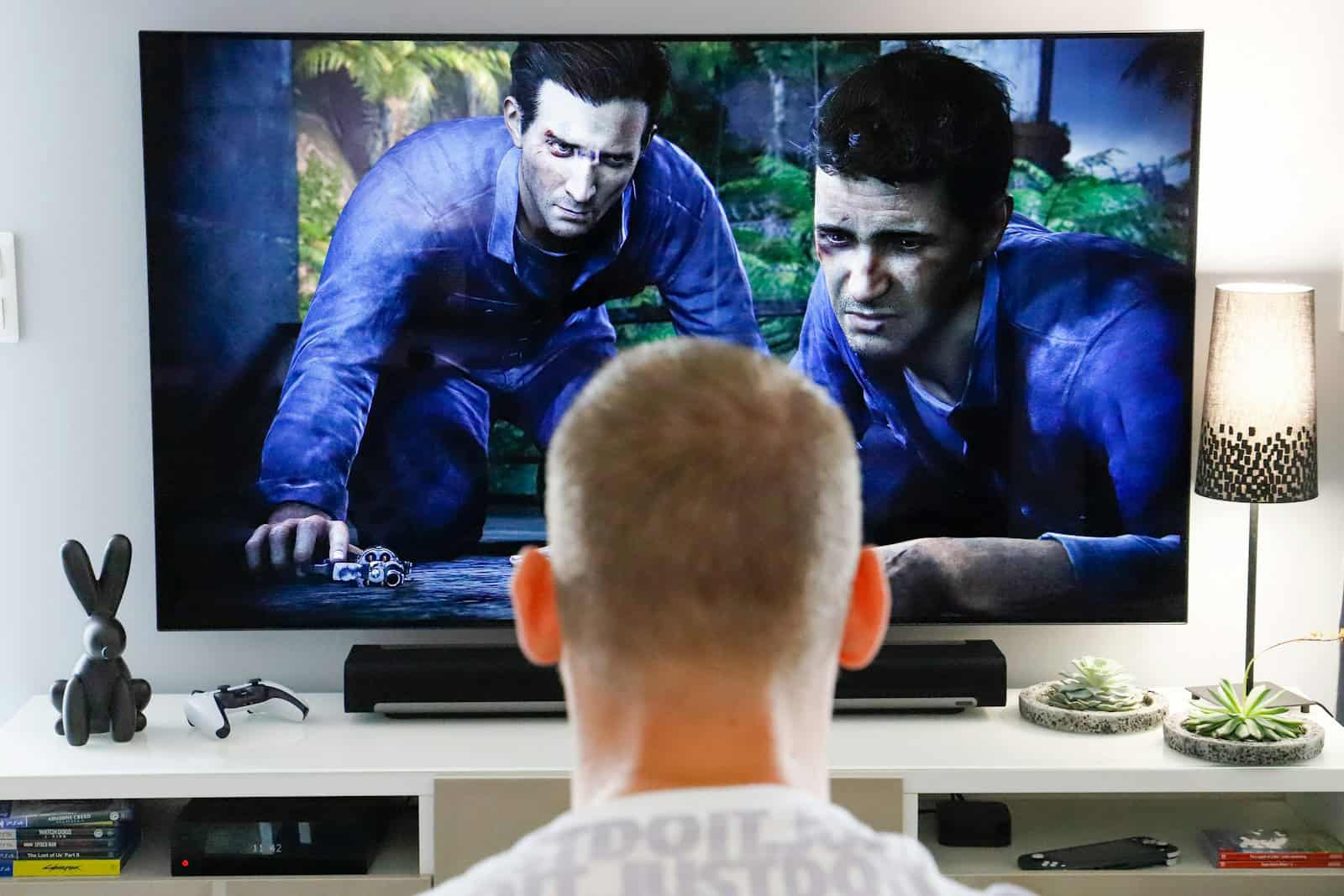Mounting a TV at the right height can make or break your viewing experience. Many people hang their TVs too high, leading to neck strain and discomfort. The ideal height for most TVs is with the center of the screen at eye level when seated, which is usually about 40-45 inches (from floor to center of TV). Said another way, this usually means the bottom of the TV should be about 25 inches above the floor.
Getting the height right depends on your specific setup. Consider your seating distance, TV size, and room layout. For a 65-inch TV, aim to sit 8 to 13.5 feet away. Larger TVs can be mounted slightly higher. The goal is comfort during long viewing sessions.
A well-mounted TV enhances your space and prevents eye strain. Take time to measure and plan before drilling holes. The extra effort pays off with a comfortable viewing experience. Your neck and eyes will thank you.
Finding the Sweet Spot: A Guide to Optimal TV Mounting Height
Mounting your TV on the wall can create a sleek and modern entertainment setup, but choosing the right height is crucial for a comfortable and immersive viewing experience. Too high, and you’ll strain your neck; too low, and you’ll miss the cinematic feel. Let’s explore the factors that influence optimal TV mounting height and provide guidelines to help you find the perfect position.

Ideal TV Mounting Height by Screen Size
| TV Size (inches) | Ideal Mounting Height (from floor to center of TV) |
|---|---|
| 40-43 | 35-40 inches |
| 48-55 | 40-45 inches |
| 60-65 | 45-50 inches |
| 70-75 | 50-55 inches |
| 80+ | 55-60 inches |
Note: These are general guidelines. Adjust the height based on your specific viewing distance, seating height, and personal preference.
Factors to Consider
- Screen Size: Larger screens generally look better when mounted slightly higher to fill your field of view.
- Viewing Distance: The further you sit from the TV, the higher it can be mounted.
- Seating Position: Consider the height of your seating and whether you typically sit upright or recline.
- Room Layout: The layout of your room, including the placement of furniture and windows, can influence the ideal mounting height.
- Personal Preference: Ultimately, the optimal height is subjective and depends on your individual comfort and viewing habits.
General Guidelines: The Rule of Thirds
A common rule of thumb is to divide the wall vertically into thirds and position the center of the TV screen at the lower third mark. This generally works well for average viewing distances and seating heights.
Fine-Tuning the Height
- Eye Level is Key: When seated in your usual viewing position, the center of the TV screen should ideally be at or slightly below your eye level. This helps minimize neck strain and ensures a comfortable viewing experience.
- Consider Viewing Angles: If you have a wide seating arrangement, consider the viewing angles from different positions in the room. You might need to adjust the height slightly to ensure everyone has a clear and unobstructed view.
- Factor in Wall Space: If you have limited wall space or are mounting the TV above a fireplace, you might need to adjust the height to accommodate these constraints.
Beyond Height: Other Mounting Considerations
- Wall Type: Ensure that the wall can support the weight of your TV. Use appropriate mounting hardware for different wall types (drywall, concrete, etc.).
- Cable Management: Conceal cables to maintain a clean and organized look.
- Tilt and Swivel Mounts: Consider using a tilt or swivel mount to adjust the TV angle for optimal viewing from different positions.
Finding Your Perfect Position
Experiment with different heights to find what feels most comfortable for you. You can use painter’s tape to mark potential positions on the wall before drilling any holes. Consider watching a few minutes of TV at each height to assess comfort and viewing angles.
Optimal TV Mounting Height: A Quick Guide
| Factor | Consideration |
|---|---|
| Screen Size | Larger screens can be mounted higher. |
| Viewing Distance | Further distance allows for higher mounting. |
| Seating Position | Aim for eye level or slightly below. |
| Room Layout | Consider furniture placement and windows. |
| Personal Preference | Experiment to find your ideal height. |
Key Takeaways
- Mount the TV with its center at seated eye level for comfort
- Consider TV size and viewing distance when choosing height
- Proper mounting prevents neck pain and eye strain
Determining Optimal Mounting Height
Finding the right height for your TV is key for comfortable viewing. It depends on your room setup and personal preferences.
Understanding Viewing Angles and Distance
The best viewing angle for a TV is straight ahead. You shouldn’t have to look up or down too much. A good rule is to have the middle of the screen at eye level when seated.
TV size matters too. Bigger TVs should be a bit higher. The distance from your couch to the TV is also important. Sit too close and you might strain your neck looking up.
For most setups the bottom of the TV should be about 25 inches from the floor. This works well for average-sized TVs and couches.
Calculating the Best TV Height for Comfort
To find the ideal TV height:
- Measure your eye level when seated
- Subtract half the TV’s height from this number
- The result is where the bottom of your TV should be
For example if your eyes are 42 inches high when seated and your TV is 34 inches tall:
42 – (34 / 2) = 25 inches
So mount the bottom of the TV 25 inches from the floor.
You can also use a simple formula: TV Height = Watching Height + (Horizontal Distance × tan(Tilt Angle))
Remember these are just guidelines. Adjust based on what feels right for you.
Choosing the Right Mount for Your Space
Selecting the proper TV mount is crucial for optimal viewing and room aesthetics. The right mount enhances functionality and complements your space’s design.
Selecting a Mount Type for Functionality and Design
Fixed mounts are ideal for dedicated viewing areas. They keep the TV flat against the wall. This type works well in smaller rooms or when seating is directly in front of the screen.
Tilting mounts allow vertical adjustment. They’re great for rooms with varied seating heights. This flexibility reduces glare and improves neck comfort.
Full-motion mounts offer the most versatility. They can extend, swivel, and tilt. These are perfect for large rooms or open floor plans. They let viewers adjust the TV angle from different spots.
Consider room size and layout when choosing. Match the mount to your viewing habits and space constraints.
Installation Tips for Various Room Settings
For living rooms, mount the TV at eye level when seated. This height typically ranges from 42 to 48 inches from the floor to the TV’s center.
In bedrooms, mount the TV slightly higher. This accommodates viewing from a reclined position. Aim for about 4 inches above seated eye level.
For kitchens or bars, mount TVs higher. This allows easy viewing while standing or sitting on tall stools.
• Use a stud finder to locate wall supports
• Ensure the mount can hold your TV’s weight
• Leave space for cable management
• Consider viewing distance when placing furniture
Always follow the manufacturer’s instructions. If unsure, hire a professional installer for safety.
Frequently Asked Questions
TV mounting height affects viewing comfort and enjoyment. The right height depends on factors like TV size and room setup. Here are answers to common questions about TV mounting height.
What is the optimal viewing height for mounting a TV on a wall?
The best height puts the center of the TV screen at eye level when seated. This is usually 40-45 inches from the floor to center. Measure from the floor to your eyes when sitting. Use this as a starting point for ideal TV placement.
Does the size of a TV affect the recommended mounting height?
Yes TV size impacts mounting height. Larger TVs should be mounted higher. This keeps the center at eye level. A 65-inch TV needs more wall space than a 40-inch TV.
How can one determine the proper height for a TV in the bedroom?
In bedrooms measure eye level when lying down. Mount the TV so the center aligns with this height. Consider using a tilting mount for better viewing angles from bed.
Is there a standard height recommendation for mounting a 65-inch TV?
For a 65-inch TV the center should be about 45-50 inches above the floor. This puts the bottom edge around 21 inches high. Adjust based on your seating and eye level.
At what height should a television be placed for the best viewing experience?
The best viewing height aligns the TV center with seated eye level. This reduces neck strain. It also improves picture quality. Aim for 40-45 inches from floor to screen center for most setups.
Are there guidelines for the distance between the floor and a mounted 55-inch TV?
For a 55-inch TV mount the bottom edge 24-28 inches above the floor. This puts the screen center at a good viewing height for most people. Adjust based on your room and seating.







